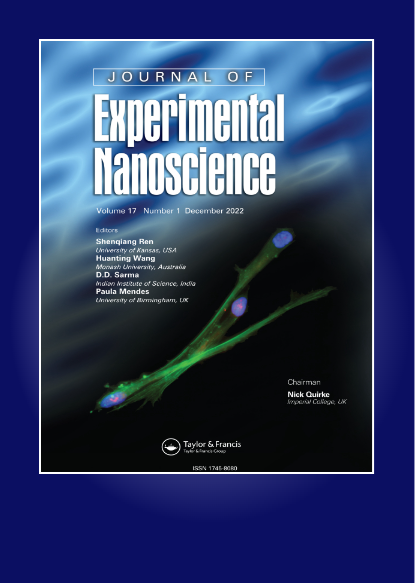果胶介导的CuO纳米颗粒绿色合成:细胞毒性、抗氧化和抗人宫颈癌特性的评价
IF 2.6
4区 材料科学
Q2 CHEMISTRY, MULTIDISCIPLINARY
引用次数: 3
摘要
摘要:从应用、简便、绿色的化学研究角度出发,本文报道了一种以果胶(PEC)为天然还原剂,在碱性介质中不使用任何有毒还原剂合成CuO纳米粒子的仿生方法。采用先进的物理化学技术,如紫外-可见(UV-Vis)、傅里叶变换红外光谱(FTIR)、扫描电子显微镜(SEM)、透射电子显微镜(TEM)、能量色散x射线能谱(EDX)和x射线衍射(XRD)研究对生物合成的CuO NPs@Pectin进行了表征。已经确定果胶稳定的铜纳米颗粒具有平均直径约为10 nm的球形。为了研究CuO NPs@Pectin对c-33a [c-33a]、SiHa、Ca Ski、DoTc2 4510、HT-3和LM-MEL-41细胞系的细胞毒性和抗人宫颈癌作用。CuO NPs@Pectin对c-33a [c-33a]、SiHa、Ca Ski、DoTc2 4510、HT-3和LM-MEL-41细胞株的IC50值分别为231、214、243、376、315和169µg/mL。以丁基羟基甲苯为阳性对照,通过DPPH试验考察了CuO NPs@Pectin的抗氧化性能。在浓度为98µg/mL时,CuO NPs@Pectin抑制了一半的DPPH分子。发现处理细胞系的细胞活力在CuO NPs@Pectin纳米复合材料上呈剂量依赖性降低。在临床试验研究中批准上述结果后,CuO NPs@Pectin可作为化疗药物用于治疗几种类型的宫颈癌。本文章由计算机程序翻译,如有差异,请以英文原文为准。
Pectin mediated green synthesis of CuO nanoparticles: evaluation of its cytotoxicity, antioxidant and anti-human cervical cancer properties
Abstract Regarding applicative, facile, green chemical research, a bio-inspired approach is being reported for the synthesis of CuO nanoparticles by pectin (PEC) as a natural reducing and stabilizing agentin alkaline medium without using any toxic reducing agent. The biosynthesized CuO NPs@Pectin were characterized by advanced physicochemical techniques like ultraviolet–visible (UV–Vis), Fourier Transformed Infrared spectroscopy (FTIR), Scanning Electron Microscopy (SEM), Transmission Electron Microscopy (TEM), Energy Dispersive X-ray spectroscopy (EDX) and X-ray Diffraction (XRD) study. It has been established that pectin-stabilized copper nanoparticles have a spherical shape with a mean diameter from approximately 10 nm. To survey the cytotoxicity and anti-human cervical cancer effects of CuO NPs@Pectin, MTT assay was used on C-33 A [c-33a], SiHa, Ca Ski, DoTc2 4510, HT-3 and LM-MEL-41 cell lines. The resulting IC50 values of the CuO NPs@Pectin against C-33 A [c-33a], SiHa, Ca Ski, DoTc2 4510, HT-3 and LM-MEL-41 cell lines were 231, 214, 243, 376, 315 and 169 µg/mL, respectively. Antioxidant properties of CuO NPs@Pectin were surveyed through the DPPH test in presence of butylated hydroxytoluene as the positive control. The CuO NPs@Pectin inhibited half of the DPPH molecules in the concentration of 98 µg/mL. The cell viability of the treated cell lines was found to reduce dose-dependently over the CuO NPs@Pectin nanocomposite. After approving the above results in the clinical trial studies, the CuO NPs@Pectin can be used as a chemotherapeutic drug for the treatment of several types of cervical cancers.
求助全文
通过发布文献求助,成功后即可免费获取论文全文。
去求助
来源期刊

Journal of Experimental Nanoscience
工程技术-材料科学:综合
CiteScore
4.10
自引率
25.00%
发文量
39
审稿时长
6.5 months
期刊介绍:
Journal of Experimental Nanoscience, an international and multidisciplinary journal, provides a showcase for advances in the experimental sciences underlying nanotechnology and nanomaterials.
The journal exists to bring together the most significant papers making original contributions to nanoscience in a range of fields including biology and biochemistry, physics, chemistry, chemical, electrical and mechanical engineering, materials, pharmaceuticals and medicine. The aim is to provide a forum in which cross fertilization between application areas, methodologies, disciplines, as well as academic and industrial researchers can take place and new developments can be encouraged.
 求助内容:
求助内容: 应助结果提醒方式:
应助结果提醒方式:


